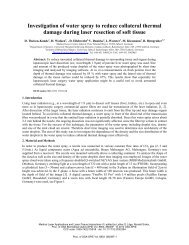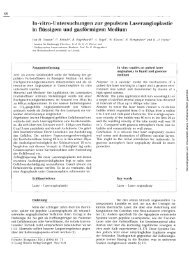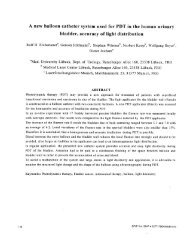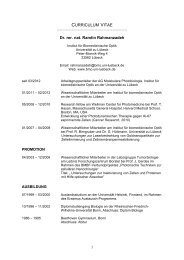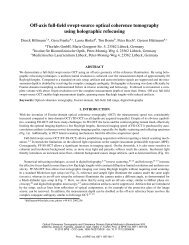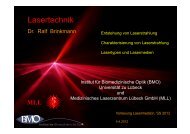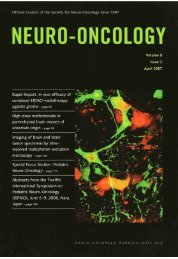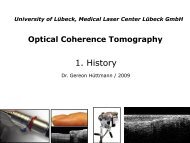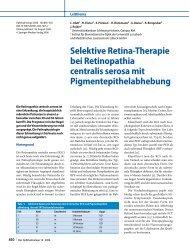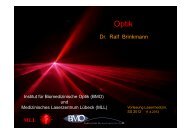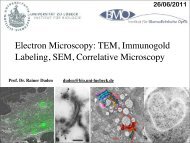Invited p aper Mechanisms of femtosecond laser nanosurgery of ...
Invited p aper Mechanisms of femtosecond laser nanosurgery of ...
Invited p aper Mechanisms of femtosecond laser nanosurgery of ...
You also want an ePaper? Increase the reach of your titles
YUMPU automatically turns print PDFs into web optimized ePapers that Google loves.
1026 Applied Physics B – Lasers and Opticspossible energy density in the vicinity <strong>of</strong> the beam waist(‘plasma shielding’) [80, 126, 136–139]. Moreover, the ϱ(I )dependence will strongly deviate from the proportionality toI k when the critical electron density ϱ ′ cr (3) is reached abovewhich the plasma becomes highly reflective. Since the reflectedlight contributes to the plasma formation in the vicinity<strong>of</strong> the focus center, the electron-density distribution isflattened. The critical electron density ϱ ′ cr for the change <strong>of</strong>the optical plasma properties amounts to 0.984 × 10 21 cm −3for λ = 1064 nm, to3.94 × 10 21 cm −3 for λ = 532 nm, andto 8.86 × 10 21 cm −3 for 355 nm, respectively. We will seein Sect. 6.3 that the threshold for bubble formation is closeto but still below these values. Therefore, the free-electrondistribution depicted in Fig. 8 seems to be a reasonable approximationfor the low-density plasma regime and suitablefor the calculation <strong>of</strong> thermoelastic transients leading to bubbleformation.4 Chemical effects <strong>of</strong> low-density plasmasPlasma-mediated chemical effects in biologicalmedia can be classified into two groups: 1. Changes <strong>of</strong> thewater molecules by which reactive oxygen species (ROS) arecreated that affect organic molecules. 2. Direct changes <strong>of</strong> theorganic molecules in resonant electron–molecule scattering.1. The creation <strong>of</strong> ROS such as OH ∗ and H 2 O 2 throughvarious pathways following ionization and dissociation <strong>of</strong> watermolecules has been investigated by Nikogosyan et al. [103]and recently reviewed by Garret et al. [143]. Both oxygenspecies are known to cause cell damage [144]. Heisterkampet al. [16] confirmed the dissociation <strong>of</strong> water molecules during<strong>femtosecond</strong>-<strong>laser</strong>-induced plasma formation by chemicalanalysis <strong>of</strong> the gas content <strong>of</strong> the bubbles.2. Capture <strong>of</strong> electrons into an antibonding molecular orbitalcan initiate fragmentation <strong>of</strong> biomolecules [143, 145–148], as shown in Fig. 9. Capture can occur when the electronpossesses a ‘resonant’ energy for which there is sufficientoverlap between the nuclear wave functions <strong>of</strong> the initialground state and the final anion state. For a molecule XY thisprocess corresponds to e − + XY → XY ∗− ,wheretheXY ∗−has a repulsive potential along the X−Y bond coordinate.After a time <strong>of</strong> 10 −15 to 10 −11 s, the transient molecular anionstate decays either by electron autodetachment leaving a vibrationallyexcited molecule (VE), or by dissociation alongone or several specific bonds such as XY ∗− → X • + Y − (DA).FIGURE 9 Dynamics <strong>of</strong> vibrational excitation and dissociative electron attachmentin resonant electron–molecule scattering (see text). Reprinted withpermission from Ref. [146]Various authors describe resonant formation <strong>of</strong> DNA strandbreaking induced by low-energy electrons (3–20 eV) [145,147, 148]. Boudaiffa et al. [145] found that the maximumsingle-strand break (SSB) and double-strand break (DSB)yields per incident electron are roughly one or two orders<strong>of</strong> magnitude larger than those for 10–25-eV photons. It isconceivable that accumulative effects <strong>of</strong> this kind can lead toa dissociation/dissection <strong>of</strong> biological structures that are exposedto <strong>femtosecond</strong>-<strong>laser</strong>-generated low-density plasmas.We will now assess the irradiance threshold for chemicalchanges by low-density plasmas using the plot <strong>of</strong>free-electron density vs irradiance presented in Fig. 3d. AtNA = 1.3 and 800-nm wavelength, one free electron per focalvolume corresponds to a density <strong>of</strong> ϱ = 2.1 × 10 13 cm −3 .Our calculations yield the result that this value is reachedat an irradiance <strong>of</strong> I = 0.26 × 10 12 Wcm −2 , which is 0.04times the irradiance threshold for breakdown defined asϱ c = ϱ cr = 10 21 cm −3 . Tirlapur et al. [144] experimentally observedmembrane dysfunction and DNA strand breaks leadingto apoptosis-like cell death after scanning irradiation <strong>of</strong> PtK2cells with a peak irradiance <strong>of</strong> I ≈ 0.44 × 10 12 Wcm −2 in thefocal region, or 0.067 times the calculated breakdown threshold.The observed damage pattern <strong>of</strong> membrane dysfunctionand DNA strand breaks matches the effects expected fromROS and free electrons. The damage resembles the type <strong>of</strong>injury otherwise associated with single-photon absorption <strong>of</strong>UV radiation [144]. However, in Tirlapur’s experiments itarose through nonlinear absorption <strong>of</strong> near-IR irradiation andthe exposure <strong>of</strong> cells to low-density plasmas. The relativeimportance <strong>of</strong> effects from ROS and free electrons at largeirradiances still needs to be investigated.In some cases, the breaking <strong>of</strong> a single bond in polymericbiological structures induces a cascade <strong>of</strong> bond-breakingevents that may be associated with a dramatic lowering <strong>of</strong> theapparent <strong>laser</strong> ablation threshold. For example, microtubulestagged with enhanced yellow fluorescent protein (EYFP)exhibit an exceptionally low threshold for <strong>laser</strong>-induced dissectionwith 76-MHz series <strong>of</strong> 532-nm, 80-ps pulses (0.01 nJper pulse) [76], and an exceptionally low threshold was alsoobserved for GFP-labeled microtubules irradiated by 80-MHzseries <strong>of</strong> 880-nm, 100-fs pulses (0.025 nJ per pulse) [77]. Thelow dissection threshold seems to be related to the dynamic instabilitybetween growth and depolymerization that involvesa rapid and self-propagating depolymerization <strong>of</strong> the ‘openends’ after local breakage <strong>of</strong> the microtubules [149, 150]. Initiation<strong>of</strong> depolymerization requires breaking <strong>of</strong> just a singlelateral bond, which could be induced either by the impact<strong>of</strong> free electrons in a low-density plasma or by multiphotonchemistry, enhanced by the EYFP or GFP labeling, respectively.Since they can be triggered by a single broken bond,these reactions differ from the usual fs <strong>laser</strong> ablation in thelow-density plasma regime that arises as a cumulative effect<strong>of</strong> many bond-breaking events.The irradiance producing lethal changes when <strong>laser</strong> pulseseries are scanned over entire cells (0.067 × I rate ) is slightlyhigher than the model prediction for the irradiance producingone free electron per pulse in the focal volume (0.04 ×I rate ), and about 10 free electrons in the focal volume will beproduced by each <strong>laser</strong> pulse. Considering that the cell is exposedto thousands <strong>of</strong> pulses during the scanning irradiation,



